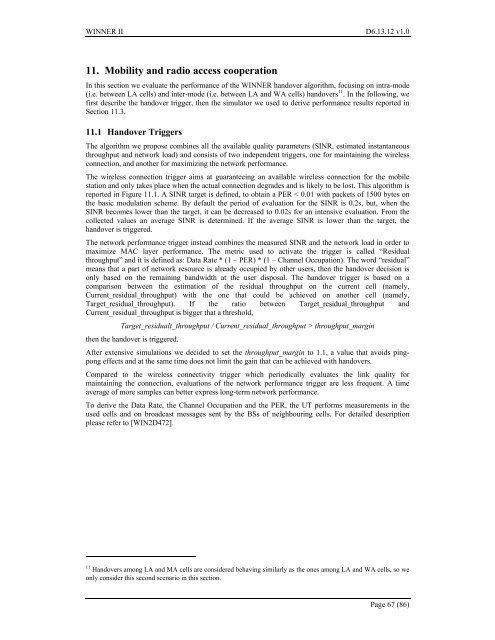IST-4-027756 WINNER II D6.13.12 v1.0 Final CG “local area ...
IST-4-027756 WINNER II D6.13.12 v1.0 Final CG “local area ...
IST-4-027756 WINNER II D6.13.12 v1.0 Final CG “local area ...
Create successful ePaper yourself
Turn your PDF publications into a flip-book with our unique Google optimized e-Paper software.
<strong>WINNER</strong> <strong>II</strong> <strong>D6.13.12</strong> <strong>v1.0</strong>11. Mobility and radio access cooperationIn this section we evaluate the performance of the <strong>WINNER</strong> handover algorithm, focusing on intra-mode(i.e. between LA cells) and inter-mode (i.e. between LA and WA cells) handovers 11 . In the following, wefirst describe the handover trigger, then the simulator we used to derive performance results reported inSection 11.3.11.1 Handover TriggersThe algorithm we propose combines all the available quality parameters (SINR, estimated instantaneousthroughput and network load) and consists of two independent triggers, one for maintaining the wirelessconnection, and another for maximizing the network performance.The wireless connection trigger aims at guaranteeing an available wireless connection for the mobilestation and only takes place when the actual connection degrades and is likely to be lost. This algorithm isreported in Figure 11.1. A SINR target is defined, to obtain a PER < 0.01 with packets of 1500 bytes onthe basic modulation scheme. By default the period of evaluation for the SINR is 0.2s, but, when theSINR becomes lower than the target, it can be decreased to 0.02s for an intensive evaluation. From thecollected values an average SINR is determined. If the average SINR is lower than the target, thehandover is triggered.The network performance trigger instead combines the measured SINR and the network load in order tomaximize MAC layer performance. The metric used to activate the trigger is called “Residualthroughput” and it is defined as: Data Rate * (1 – PER) * (1 – Channel Occupation). The word “residual”means that a part of network resource is already occupied by other users, then the handover decision isonly based on the remaining bandwidth at the user disposal. The handover trigger is based on acomparison between the estimation of the residual throughput on the current cell (namely,Current_residual_throughput) with the one that could be achieved on another cell (namely,Target_residual_throughput). If the ratio between Target_residual_throughput andCurrent_residual_throughput is bigger that a threshold,Target_residualt_throughput / Current_residual_throughput > throughput_marginthen the handover is triggered.After extensive simulations we decided to set the throughput_margin to 1.1, a value that avoids pingpongeffects and at the same time does not limit the gain that can be achieved with handovers.Compared to the wireless connectivity trigger which periodically evaluates the link quality formaintaining the connection, evaluations of the network performance trigger are less frequent. A timeaverage of more samples can better express long-term network performance.To derive the Data Rate, the Channel Occupation and the PER, the UT performs measurements in theused cells and on broadcast messages sent by the BSs of neighbouring cells. For detailed descriptionplease refer to [WIN2D472].11 Handovers among LA and MA cells are considered behaving similarly as the ones among LA and WA cells, so weonly consider this second scenario in this section.Page 67 (86)
















